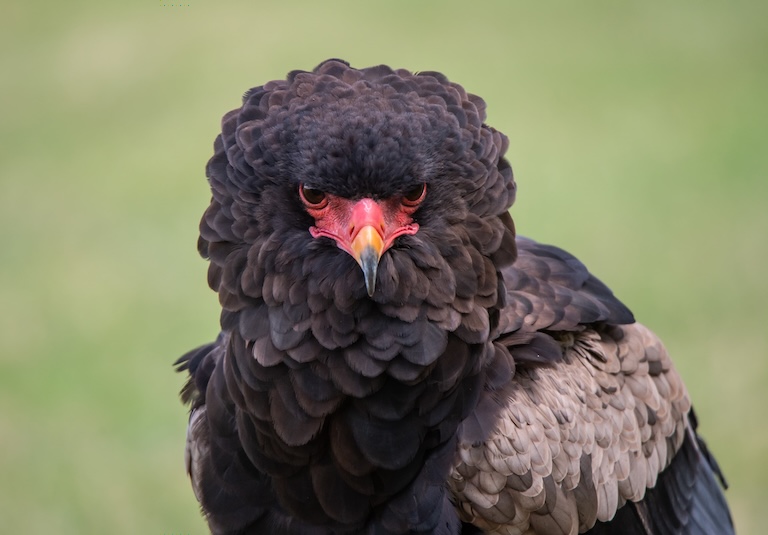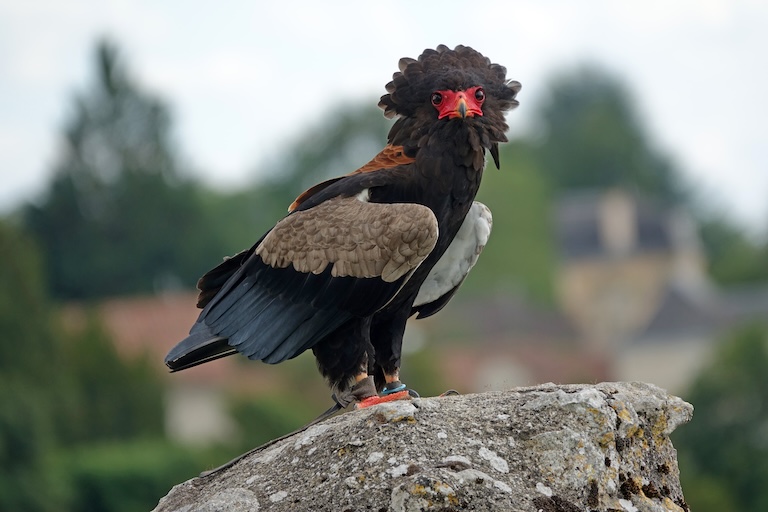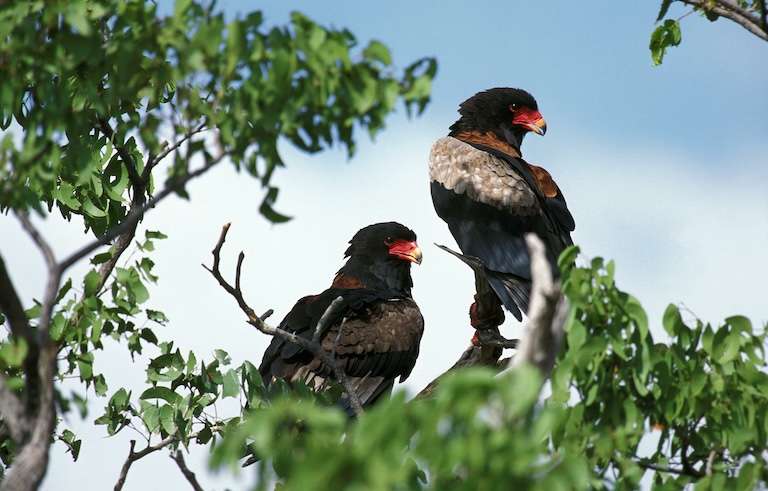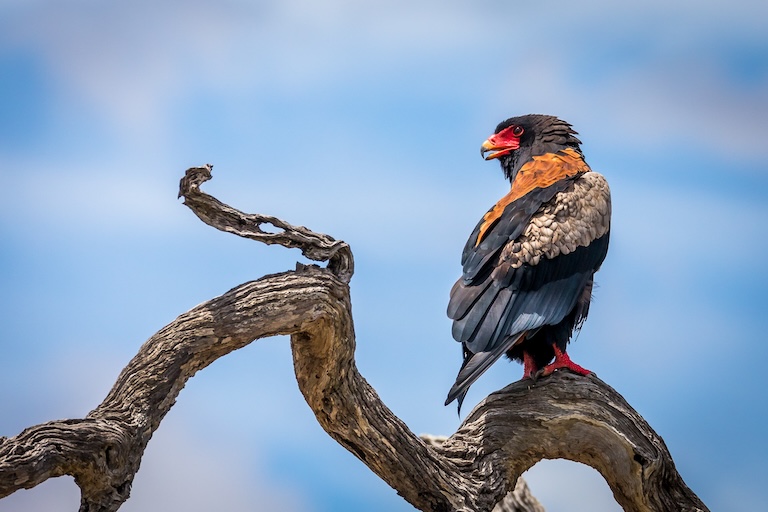Bateleur Eagle Profile
Spielberg really did a number on kids growing up in the ‘90s. Making Brachiosaurs stand on their hind legs, velociraptors without any feathers and a T-rex that could roar – it just sets everyone up for disappointment when they finally grow up and meet one in the wild.
But there’s one dinosaur that even Spielberg couldn’t improve on. Stunningly ferocious, bigger than you might expect and with speed and agility that give it the nickname of a French acrobat: the Bateleur.

Bateleur Eagle Facts Overview
| Habitat: | Open savanna country and woodland, some desert |
| Location: | Sub-Saharan Africa, Middle East |
| Lifespan: | 27 in the wild, possibly 40 in captivity |
| Size: | 55 to 70 cm (22 to 28 in) long, up to 190 cm (6 ft 3 in) wingspan |
| Weight: | Up to 3 kg (6.6 lb) |
| Colour: | Black, white, grey, rusty brown, with a red face |
| Diet: | Generalist predators: antelope, mice, birds, snakes, carrion, lizards |
| Predators: | Baboons, genets, African wildcats, tree monitors, larger raptors |
| Top Speed: | 80 km/h (50 mph) |
| No. of Species: | 1 |
| Conservation Status: | Endangered |
Bateleur eagles are part of the snake eagle group, but like their equally astonishing cousins, the Philippine eagles, they lack the dogmatic approach to diet found in most of the subfamily.
These iconic generalists are instantly recognisable for their good looks, dance moves and distinctive aerial acrobatics, and they have a bunch of other quirks, too.
But make no mistake: they are still a terrifying presence for any medium-sized animal to contend with.
Interesting Bateleur Eagle Facts
1. They’re Accipitrids
The order Accipitridae contains a who’s who of iconic predatory birds. This is where hawks, kites, and eagles live, and the latter is split into four informal groupings. The fish eagles, booted eagles, harpy eagles and the snake eagles, the latter being where you can find the Bateleur.
This isn’t a strictly taxonomic system; for example, the Philippine eagle is sometimes placed in either the snake eagle or the harpy eagle group, but generally, snake eagles are known for their specialised hunting techniques.
Bateleurs are a bit different. They are of course accomplished hunters, but they don’t toe the line like most of the others.

2. They’ll eat anything
Far from limiting themselves to one branch of squamates, these eagles are adventurous foodies and will branch out into other reptiles, too.
They’ll also take small mammals like rodents, slightly larger mammals, such as antelope, and also birds, carrion and insects; or even crabs, eggs, or really whatever they can find lying around.
They are open country specialists, not very migratory, and can be seen from very far away on account of their distinctive appearance.
3. Astonishing face, no tail
This sounds like a derogatory judgement from the ‘40s, but it’s the translation of the Bateleur’s Latin name, Terathopius ecaudatus, and hints at the distinctive appearance of this incredible bird.
It is one of the easiest raptors to recognise, not only because of its bright red face and contrasting black and white plumage but also its presence in the sky.
With a wingspan of almost two metres, it soars with distinctive wing tip feathers and the characteristic short-tailed silhouette with its feet dangling out behind it.
And it’ll do this for hours. 1
4. They fly a lot
This eagle can easily spend a full shift in the air, racking up more than enough hours for its private pilot’s licence in a single week: sometimes up to nine hours a day.
They hunt in the light and might cover an area of 650 km2 in a single day. Around 80% of their waking hours are spent on the wing, and while gliding, it’s often spotted rocking their wings from side to side – a behaviour that likely got it named after French tightrope walkers or street performers, the Bateleurs. 2
5. They’re snotty
This group of raptors secrete a clear, salty fluid from the nostrils like the stuff you see on the faces of other people’s small children you don’t want anywhere near you.
It’s not clear why they do this, but it’s thought to be some form of salt secretion that may aid in water absorption because their kidneys aren’t enough to do the job on their own.
This definitely deducts a point of charisma from the Bateleur, but it has so many to begin with, that barely makes a dent.

6. They dance
The French name for this eagle is a nod to its acrobatic talents, but it seems there’s no end to ways this thing can move.
Courtship displays involve gliding and rocking, which we’ve touched on already, but also somersaults, dives, clapping and even screaming while doing it – not unlike a tightrope walker that fell off. They will also spread their wings and bow to their focus of attention.
But they also appear to like wiggling for the camera, as a popular clip of the Bateleur shaking out its feathers shows that any motion by this bird is a smooth one.
Finally, these birds also spend a lot of time sunbathing to keep warm and waterbathing to keep cool. Both of these events involve looking amazing while doing them. 3 4
7. They’re being poisoned
Sadly, their incredible presence hasn’t been enough to protect them, and being carrion-feeders, they have developed a reputation among ignorant farmers for murdering livestock.
As a result, poisonings occur a lot, and it has put a huge dent in the population to the point where they are now endangered.
This is really the only thing that threatens the species, so there’s still hope that educating people can save them, but for now, they are still in steep decline.

Bateleur Eagle Fact-File Summary
Scientific Classification
| Kingdom: | Animalia |
| Phylum: | Chordata |
| Class: | Aves |
| Order: | Accipitriformes |
| Family: | Accipitridae |
| Genus: | Terathopius |
| Species: | ecaudatus |
Fact Sources & References
- That’s Wild (2024), “The Real Life Phoenix Bird | The Bateleur Eagle”, YouTube.
- Safari Chey (2017), “Sunset- Such a graceful flight of the Bateleur”, YouTube.
- perytonn (2001), “Bateleur Display”, YouTube.
- WhoRangTheBell (2019), “The Dance of the Cardi B.ateleur Eagle”, YouTube.
